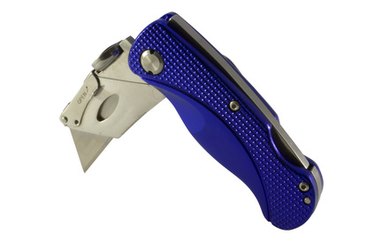
The Stanley Tool company began as the Stanley Works manufacturing company in Connecticut in 1843, manufacturing bolt and door hardware. Stanley now produces a variety of tools, including a number of knife products. Stanley produces many blade styles, from retractable utility knives used to cut through boxes and tape to fixed-blade knives that can cut through heavy construction equipment. Regardless of the type of Stanley blade you use, safety is always key to ensure that the blade does not harm you or anyone else; proper precautions when using the knives can prevent injury.
Step 1
Wear protective goggles whenever you cut with a Stanley knife. The sharp cutting blades can release shrapnel from the cutting surfaces, possibly harming your eyes.
Video of the Day
Step 2
Check your knife before each cutting application to make sure that the blade is securely seated in the knife. Stanley blades are replaceable, meaning that they slide in and out of the knife as needed to ensure a sharp blade. Before you cut, make sure the blade is not loose; if the blade is retractable, make sure it is fully extended before cutting.
Step 3
Stand firmly in front of your cutting surface with both feet securely planted. If you are cutting on a surface that is below chest level, kneel or stand to one side of the cutting line so that you have the best control of the blade and your body is out of the way of the cutting edge.
Step 4
Plant your free hand in an area where it can support you if needed. Make sure your hand is at least 6 inches from the cutting line, so that if the blade slips you have time to move your hand before it is injured.
Step 5
Pull the knife toward you as you cut; do not push the blade away from you on a cutting line. A pulling motion is stronger than a pushing motion, making for a faster and more efficient cut. The blade is also less likely to slip when you pull it, as opposed to push it away from you.
Step 6
Make several passes with the blade if you are cutting through a thick surface. Several shallow cuts will penetrate deeper and faster into a thick material than trying to force the blade through in one cut; there is also less of a chance of the blade slipping or breaking in the process.
Step 7
Replace the Stanley blade whenever it becomes dull. If the blade seems to be tearing material instead of cutting through it, you know it is time for a new blade. Dull blades can slip more easily than sharp ones, creating a safety hazard.
Tip
If you are cutting along a straight edge or guide, clamp it down or support the far edge with your free hand so that your hand remains well out of the cutting line. Make sure the straight edge is thick enough so that if the blade slips, it will not ride over the edge and get to your hand.
Warning
Never leave a Stanley knife unattended with the blade in an exposed position. Remove the blade from the knife or retract it before putting it down. Stanley offers self-retracting blades that automatically retract when you release the knife handle.
Never apply side pressure to a Stanley blade, like the pressure caused by prying loose objects or opening cans or bottles. The Stanley blades are brittle, and will snap if uneven side pressure is applied.
Video of the Day